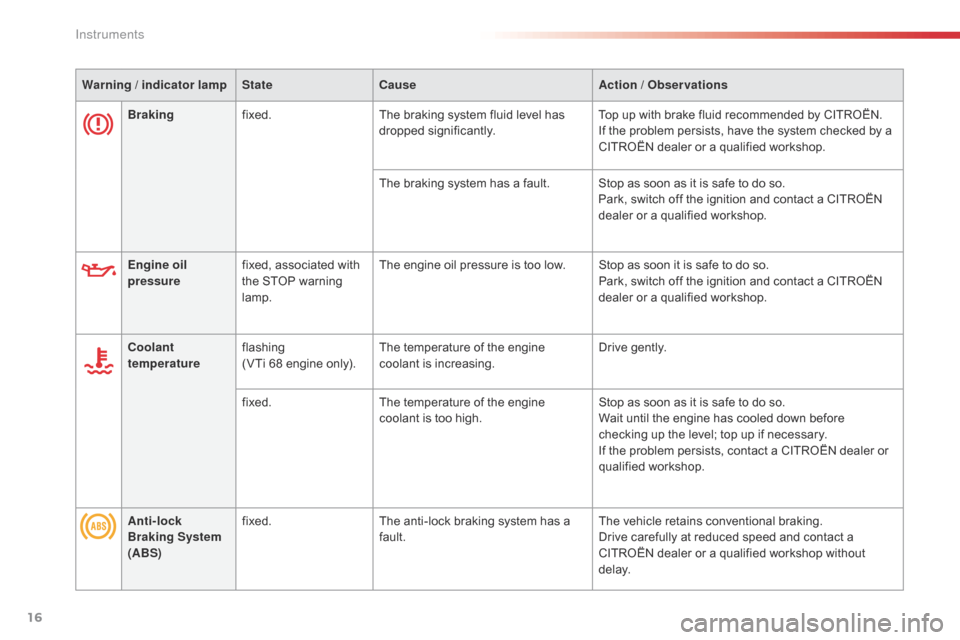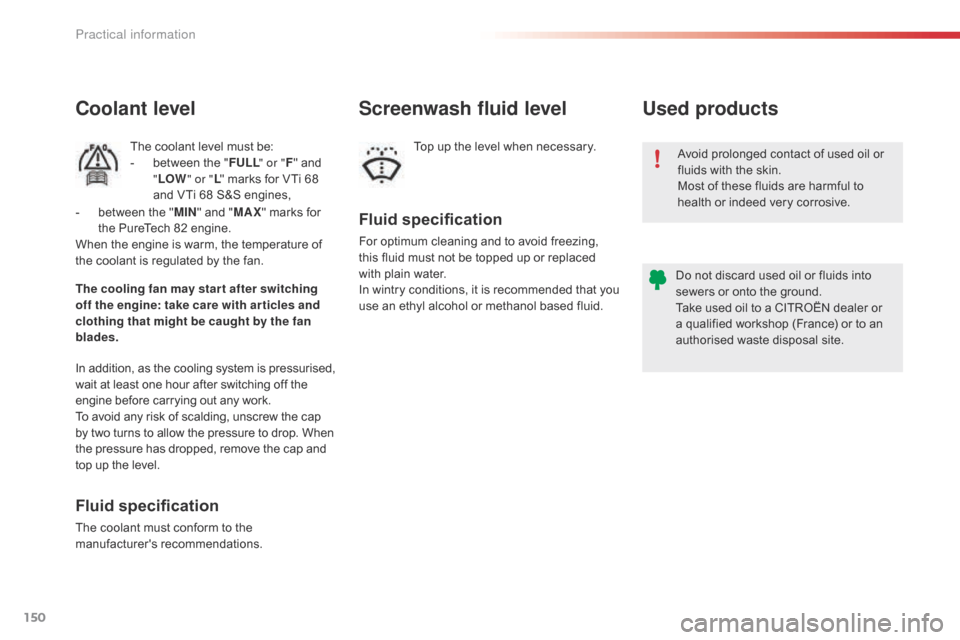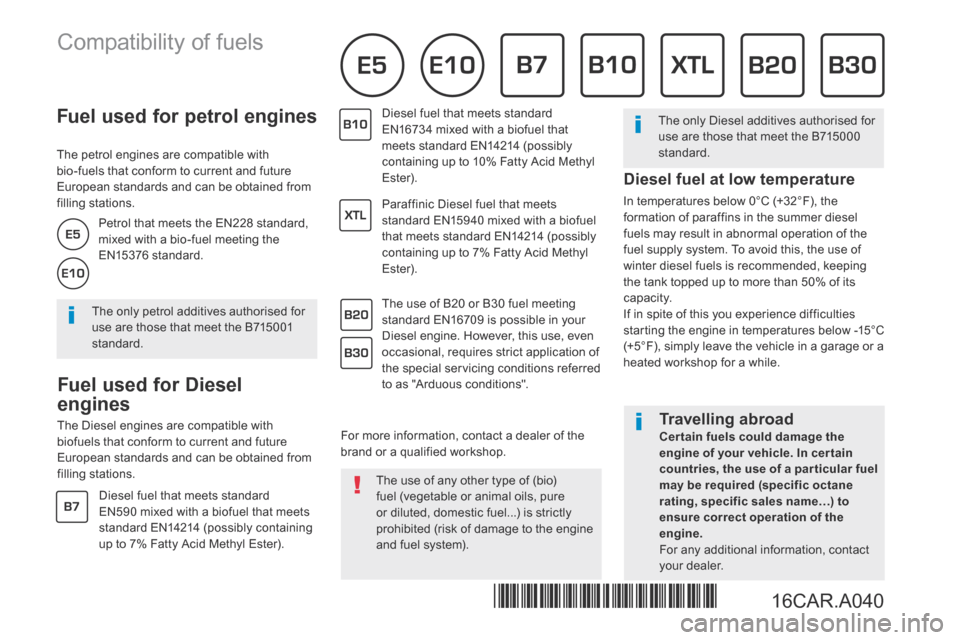oil temperature Citroen C1 2016 1.G Owner's Manual
[x] Cancel search | Manufacturer: CITROEN, Model Year: 2016, Model line: C1, Model: Citroen C1 2016 1.GPages: 269, PDF Size: 7.63 MB
Page 18 of 269

16
Brakingfixed. The  braking  system  fluid  level  has  d
ropped s ignificantly.Top
 up  with  brake  fluid  recommended  by  CITROËN.
If  the  problem  persists,  have  the  system  checked  by  a Â
C
ITROËN  dealer  or  a  qualified  workshop.
The
 braking  system  has  a  fault. Stop  as  soon  as  it  is  safe  to  do  so.
Park,
 switch  off  the  ignition  and  contact  a  CITROĂ‹N Â
d
ealer  or  a  qualified  workshop.
Warning
/ indicator lamp
State Cause Action
/ Observations
Engine oil
pressure fixed,
 associated  with Â
t
he  STOP  warning Â
lam
p.The
 engine  oil  pressure  is  too  low. Stop  as  soon  it  is  safe  to  do  so.
Park,
 switch  off  the  ignition  and  contact  a  CITROĂ‹N Â
d
ealer  or  a  qualified  workshop.
Coolant
temperature flashing
Â
(
VTi  68  engine  only).The
 temperature  of  the  engine Â
c
oolant
 i
s
 inc
reasing.Drive
 gently.
fixed. The
 temperature  of  the  engine Â
c
oolant  is  too  high.Stop
 as  soon  as  it  is  safe  to  do  so.
Wait
 until  the  engine  has  cooled  down  before Â
c
hecking  up  the  level;  top  up  if  necessary.
If
 the  problem  persists,  contact  a  CITROĂ‹N  dealer  or Â
q
ualified
 w
orkshop.
Anti-lock
Braking System
(ABS) fixed.
The
 anti-lock  braking  system  has  a Â
f
ault.The
 vehicle  retains  conventional  braking.
Drive
 carefully  at  reduced  speed  and  contact  a Â
C
ITROĂ‹N  dealer  or  a  qualified  workshop  without Â
d
e l ay.
Instruments
Page 152 of 269

150
C1_en_Chap07_info-pratiques_ed01-2016
Avoid prolonged contact of used oil or fluids  with  the  skin.
Most
 of  these  fluids  are  harmful  to Â
h
ealth  or  indeed  very  corrosive.
Do
 not  discard  used  oil  or  fluids  into Â
s
ewers  or  onto  the  ground.
Take
 used  oil  to  a  CITROĂ‹N  dealer  or Â
a
 qualified  workshop  (France)  or  to  an Â
a
uthorised  waste  disposal  site.
Used products
Fluid specification
For optimum cleaning and to avoid freezing, this  fluid  must  not  be  topped  up  or  replaced Â
w
ith  plain  water.
In
Â
w
intry Â
c
onditions, Â
i
t Â
i
s Â
r
ecommended Â
t
hat Â
y
ou Â
u
se  an  ethyl  alcohol  or  methanol  based  fluid.
Screenwash fluid level
Top up the level when necessary.
Coolant level
The coolant level must be:
-  b etween  the  "FULL " or "F"
 and Â
"LO
W" or " L"
 marks  for  VTi  68 Â
a
nd  VTi  68  S&S  engines,
In
Â
addition,  as  the  cooling  system  is  pressurised,
 w
ait
Â
at
Â
least  one  hour  after  switching  off  the
 e
ngine
Â
before  carrying  out  any  work.
To
Â
avoid
Â
any  risk  of  scalding,  unscrew  the  cap
 b
y
Â
two
Â
turns  to  allow  the  pressure  to  drop.  When
 t
he
Â
pressure  has  dropped,  remove  the  cap  and
 t
op
Â
up
Â
the
 level.
Fluid specification
The coolant must conform to the ma nufacturer's r ecommendations.
The cooling fan may star t after switching
off the engine: take care with ar ticles and
clothing that might be caught by the fan
blades. - Â
b
etween  the  "
MIN "  and  "
MAX "  marks  for Â
t
he  PureTech  82  engine.
When  the  engine  is  warm,  the  temperature  of Â
t
he  coolant  is  regulated  by  the  fan.
Practical information
Page 269 of 269

Fuel used for petrol engines
The petrol engines are compatible with bio-fuels that conform to current and future European standards and can be obtained from filling stations.
Fuel used for Diesel
engines
The Diesel engines are compatible with biofuels that conform to current and future European standards and can be obtained from filling stations.
The use of B20 or B30 fuel meeting standard EN16709 is possible in your Diesel engine. However, this use, even occasional, requires strict application of the special servicing conditions referred to as "Arduous conditions".
The use of any other type of (bio)fuel (vegetable or animal oils, pure or diluted, domestic fuel...) is strictly prohibited (risk of damage to the engine and fuel system).
The only Diesel additives authorised for use are those that meet the B715000 standard.
The only petrol additives authorised for use are those that meet the B715001 standard.
Petrol that meets the EN228 standard, mixed with a bio-fuel meeting the EN15376 standard.
Travelling abroad Cer tain fuels could damage the engine of your vehicle. In cer tain countries, the use of a par ticular fuel may be required (specific octane rating, specific sales name…) to ensure correct operation of the
engine. For any additional information, contact your dealer.
Diesel fuel that meets standard EN590 mixed with a biofuel that meets standard EN14214 (possibly containing up to 7% Fatty Acid Methyl Ester).
Diesel fuel that meets standard EN16734 mixed with a biofuel that meets standard EN14214 (possibly containing up to 10% Fatty Acid Methyl Ester).
Paraffinic Diesel fuel that meets standard EN15940 mixed with a biofuel that meets standard EN14214 (possibly containing up to 7% Fatty Acid Methyl Ester).
For more information, contact a dealer of the brand or a qualified workshop.
Compatibility of fuels
Diesel fuel at low temperature
In temperatures below 0°C (+32°F), the formation of paraffins in the summer diesel fuels may result in abnormal operation of the fuel supply system. To avoid this, the use of winter diesel fuels is recommended, keeping
the tank topped up to more than 50% of its capacity. If in spite of this you experience difficulties starting the engine in temperatures below -15°C (+5°F), simply leave the vehicle in a garage or a heated workshop for a while.
16CAR.A040*16CAR.A040*